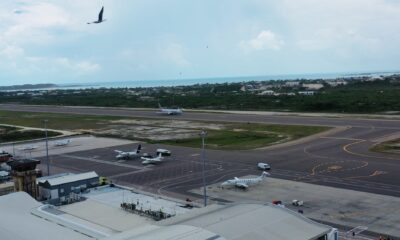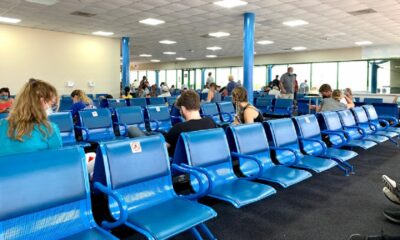By Deandrea Hamilton
Editor
#TurksandCaicos, March 21, 2022 – Government and the Turks and Caicos Islands Airports Authority (TCIAA) can no longer get away with saying the ‘overcrowding’ at the airport is a ‘good problem to have’, it is now becoming increasingly risky from a health perspective and condemning – reputationally – for a destination renown as a luxury escape.
The consistent marketing of the Turks and Caicos, which is a British Overseas Territory, as an elite Caribbean region getaway is working marvellously, but the plans to brace for the booming interest in TCI holidays are lagging dangerous behind; the results and optics are disastrous.
Wrong last impression
On the afternoon of Saturday March 19, hundreds of tourists were filmed on cell phone video smashed together like sardines at the Providenciales International Airport (PLS). Obviously frustrated, agitated and incensed by the horrendous lines at the outdoor-styled departure area; the guests were moaning in disbelief.
All Covid-19 physical distancing protocols had to be ignored; it was impossible to distance anyone. There were too many people and no space to cater to them as they queued up. The lines for flight check-in and security check points were most definitely blurred.
“Today we processed a total of Four-thousand, thirty-one (4031) passengers and Twenty-seven (27) commercial flights. Due to infrastructural limitations, in combination with flight delays of 30-60 minutes we experienced congestion issues beyond expected,” said the TCIAA in a statement issued Saturday night.
In one video, children were captured seated on the grimy ground of a parking lot which is used as a holding area for ground transportation at the PLS.
To all reading that statement, it seemed the TCIAA and the Ministry of Border Services were caught unprepared for the travel traffic and proved to be a weak link in the experiential tourism chain.
Everyone Knew it was Coming
In 2021, the Turks and Caicos recorded its best year for tourism and real estate sales, according to Premier Washington Misick, in his 200-day in office report.
“All signs point to an economy on the rebound, said Premier Washington Misick in September 2021, when he gave a National Address.
“Preliminary figures show, that during the first half of this year visitor arrivals increased by approximately 34.5 per cent compared to the same period last year. Merchandise imports into the Turks and Caicos Islands during the first half of this year totalled $215.6 million. This represents an increase of $30.6 million or 16.9% percent when compared to the same period in 2020. The Recurrent Revenue of $165.4 million at August, exceeded budget by $39.5 million. The major revenue drivers are: Stamp duty on land transactions – $44m; Hotel and Restaurant Tax – $36m; Customs processing and Import duties – $42m.”
compared to the same period in 2020. The Recurrent Revenue of $165.4 million at August, exceeded budget by $39.5 million. The major revenue drivers are: Stamp duty on land transactions – $44m; Hotel and Restaurant Tax – $36m; Customs processing and Import duties – $42m.”
Easier getting in, tougher getting out, both bad.
Our newsroom was informed by passengers that disembarkation is also a nightmare. Up to 30-minutes waiting in the landed plane for guests is frustrating we are told, but admittedly more kind that having the arriving passengers standing in the open elements which would be far more unbearable.
Exiting the TCI by commercial flight at the PLS is taking up to three hours.
“Tourism numbers have grown considerably over the past several years, and we understand that this growth necessitates an airport redevelopment plan, which has remained a top priority for us. Long-term development strategies are being progressed to support decision making for a new terminal building, ancillary facilities, upgrades to our taxiway system and airfield, to provide an improved passenger experience. Various short-term measures continue to be explored whilst we work towards the expansion of the airport as a permanent solution,” said the TCIAA.
Since it is out of the question that Turks and Caicos plug up the enviable tourism boom, the question now becomes what can be done to deliver more comfortable service until the long term plans for the country’s #1 airline gateway are actualized.
A canopy was due to be constructed on the airport tarmac by now; it is supposed to accommodate hundreds of arriving passengers. Inexplicably, it remains unconstructed.
An Old Problem
Tourism arrivals for the Turks and Caicos have been on an annual upward trajectory. In 2019, the country hit a fabulous stride and that is also about the time videos of overcrowding began to surface. They showed horrendous lines outside of arrivals and as travellers departed.
The situation exposed an unfavourable problem which many blamed on a short-sighted expansion of a little over a decade ago.
It is well documented that the airport expansion of 2010-2014 came in two phases at a cost of $10 million cumulatively. It was said to nearly double the size of the terminal from 51,462 to 92,321 sq. ft but it was also criticised as many suspected the design offered no protection from the unpredictable elements and the enlarged facility was still insufficient.
Residents say they are tired of hearing the Government of the day, pat itself on the back for strong tourism performance and then fail to provide the infrastructure and public amenities to in order to give people an end to end exceptional experience.
Islanders also believe they deserve a better experience as travellers and workers at the Providenciales International Airport.
While the TCIAA explained the situation, yet again, there was no announcement about the mitigation efforts planned to cope with the next big rush, which is now about four days away.
“Our team, in partnership with our stakeholders are working assiduously to provide a more smoother passenger flow through the terminal building.
We apologize for any inconvenience caused on these unique peak days. We remain committed to provide the greatest level of comfort possible for our valued travelers.”
UPDATED…

 News6 days ago
News6 days ago
 Health6 days ago
Health6 days ago
 TCI News2 days ago
TCI News2 days ago
 Caribbean News5 days ago
Caribbean News5 days ago
 Education5 days ago
Education5 days ago
 Caribbean News1 week ago
Caribbean News1 week ago
 Caribbean News5 days ago
Caribbean News5 days ago
 Bahamas News1 week ago
Bahamas News1 week ago



























